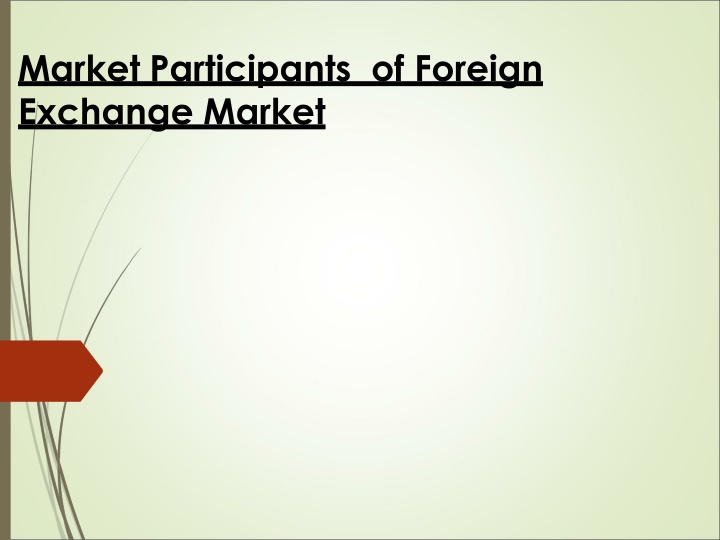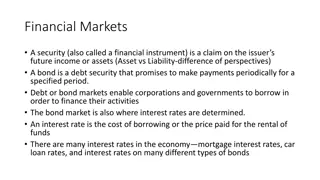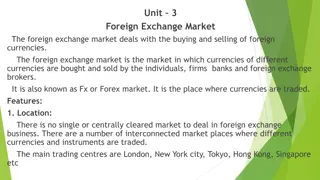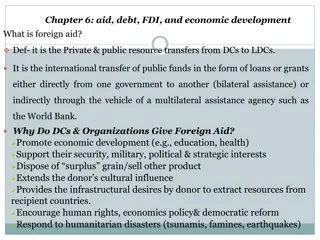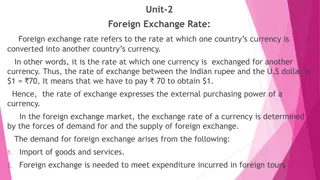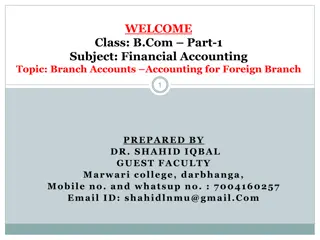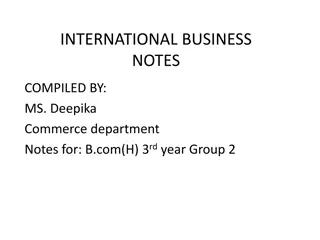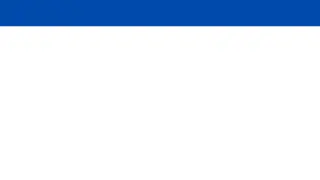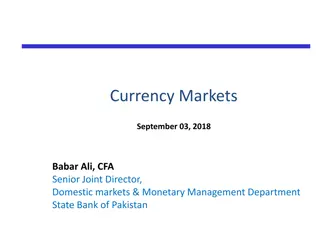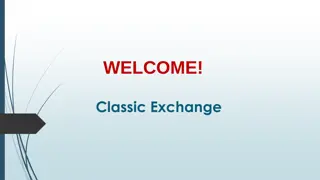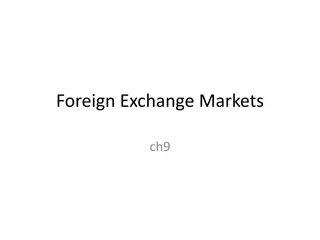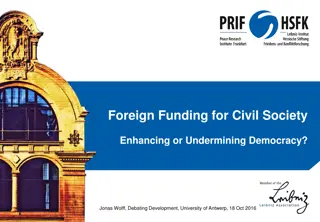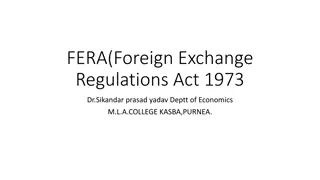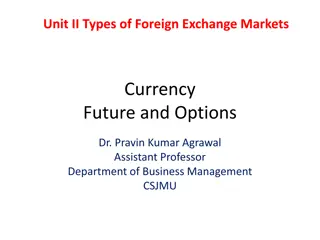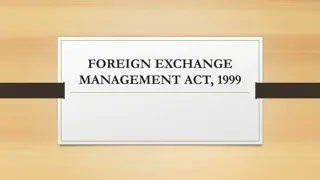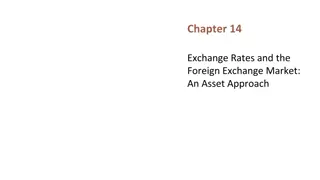Market Participants of Foreign Exchange Market
Participants in the foreign exchange market include bank dealers, individuals, speculators, central banks, and brokers. Each category plays a unique role in trading and influencing currency exchange rates. Bank and non-bank dealers profit from bid/ask spreads, while individuals and firms use the market for commercial transactions. Speculators and arbitragers aim to profit from exchange rate movements, and central banks utilize the market to manage country reserves and currency value. Foreign exchange brokers facilitate transactions between dealers, ensuring anonymity and efficient trading.
Download Presentation

Please find below an Image/Link to download the presentation.
The content on the website is provided AS IS for your information and personal use only. It may not be sold, licensed, or shared on other websites without obtaining consent from the author.If you encounter any issues during the download, it is possible that the publisher has removed the file from their server.
You are allowed to download the files provided on this website for personal or commercial use, subject to the condition that they are used lawfully. All files are the property of their respective owners.
The content on the website is provided AS IS for your information and personal use only. It may not be sold, licensed, or shared on other websites without obtaining consent from the author.
E N D
Presentation Transcript
Market Participants of Foreign Exchange Market
Market Participants Four broad categories of participants: Bank dealers, exchange and non-bank foreign Individuals and firms, Speculators and arbitragers, and Central banks and treasuries. Foreign Exchange Brokers
Bank and Non-bank Foreign Exchange Dealers Banks and a few non-bank foreign exchange dealers operate in both the inter-bank and client markets. The profit from buying foreign exchange at a bid price and reselling it at a slightly higher offer or ask price. Dealers in large international banks often function as market makers. These dealers stand willing at all times to buy and sell those currencies in which they specialize and thus maintain an inventory position in those currencies.
Individuals and Firms Individuals (such as tourists) and firms (such as importers, exporters commercial and investment transactions in the foreign exchange market. and MNEs) conduct Their use of the foreign exchange market is necessary for their underlying commercial or investment purpose. Some of the participants use the market to hedge foreign exchange risk.
Speculators and Arbitragers Speculators and arbitragers seek to profit from trading in the market itself. They operate in their own interest, without a need or obligation to serve continuous market. clients or ensure a While speculators seek all the profit from exchange rate changes and arbitragers simultaneous exchange different markets. dealers seek the bid/ask spread, try to differences profit from rate in
Central Banks and Treasuries Central banks and treasuries use the market to acquire or spend their country s foreign exchange reserves as well as to influence the price at which their own currency is traded. The motive is not to earn a profit Central banks and treasuries differ in motive from all other market participants.
Foreign Exchange Brokers Foreign facilitate themselves transaction. exchange trading brokers between are dealers principals agents who without in becoming the For this service, they charge a commission. It is a brokers business to know at any moment exactly which dealers want to buy or sell any currency. Dealers use brokers for their speed, and because they want to remain anonymous since the identity of the participants may influence short term quotes.
Market-makers Traders in the major money center banks around the world who deal in two-way prices. They announce bid and offer prices at which they will exchange two currencies. The difference between the two prices is referred to as the bid/asked spread, which is traders profits. Bid (ask or offer) price = a price at which a trader is willing to buy (sell).
Transactions in the Inter-bank Market A spot transaction in the inter-bank market is the purchase of foreign exchange, with delivery and payment between banks to take place on the second following business day. The date of settlement is referred to as the value date. An outright forward transaction (or a forward) requires delivery at a future value date of a specified amount of one currency for a specified amount of another currency.
Transactions in the Inter-bank Market The exchange rate is established at the time of the agreement, but payment and delivery are not required until maturity. Forward exchange rates are usually quoted for value dates of one, two, three, six and twelve months. A swap transaction in the inter-bank market is the simultaneous purchase amount of foreign exchange for two different value dates (settlement date). and sale of a given
Transactions in the Inter-bank Market Both purchase and sale are conducted with the same counterparty. Some different types of swaps are: o o o non-deliverable forwards (NDF). spot against forward, forward-forward,
Foreign Exchange Rates and Quotations A foreign exchange rate is the price of one currency expressed in terms of another currency. A foreign exchange quotation (or quote) is a statement of willingness to buy or sell at an announced rate. Most foreign exchange transactions involve the US dollar.
Professional dealers and brokers may state foreign exchange quotations in one of two ways: o the foreign currency price of one dollar, or o the dollar price of a unit of foreign currency. Most foreign currencies in the world are stated in terms of the number of units of foreign currency needed to buy one dollar.
Foreign exchange quotes: o o indirect quote direct or A direct quote is a home currency price of a unit of foreign currency An indirect quote is a foreign currency price of a unit of home currency. The form of the quote depends on what the speaker regard as home. For example, the exchange rate between US dollars and the Swiss franc is normally stated: o SF 1.6000/$ (European terms or direct quote)
However, this rate can also be stated as: o $0.6250/SF (American terms or indirect quote) most inter-bank quotations around the world are stated in European terms. Forward quotations may also be expressed as the percent-per-annum deviation from the spot rate. This method of quotation makes it easier to compare premiums or discounts in the forward market
If a currency increases in value in the future, it is traded at a premium, if decreases, it is at a discount against the other currency. Some currency pairs are only inactively traded, so their exchange rate is determined through their relationship to a widely traded third currency (cross rate). Cross rates can be used to check on opportunities for inter-market arbitrage. one bank s (Dresdner) quotation on / is not the same as calculated cross rate between $/ (Barclay s) and $/ (Citibank).
Understanding Exchange Rates Dollar/Swiss Francs -- USD/CHF Note the order of the currencies USD comes before the CHF The first currency($) - Base currency Second currency (CHF) - Terms currency It is important to remember that Bid & Offer in trading always refers to the BASE CURRENCY.
Forward Rates Rate agreed for settlement on an agreed date in the future All rates are derived from Spot rates Forward rate is the spot rate adjusted for the premium / discount Forward Rate = discount Spot Rate + / - premium or
Premium/Discount Forward price = Spot price plus or minus forward margin. Premium forward value of currency is higher than spot rate. A currency with lower rate of interest is said to be at premium in the forwards. Forward margins added to spot rate. Discount forward value of currency is lower than spot rate. A currency with higher rate of interest is said to be at discount. Forward margins deducted from spot rate.
Factors Determining Exchange Rates a. Fundamental Reasons: Balance of Payment surplus leads to stronger currency. Economic Growth Rates High/Low growth rate. Fiscal / Monetary Policy- deficit financing leads to depreciation of currency. Interest Rates currency with higher interest will appreciate in the short term. Political Issues Political stability leads to stable rates
Factors Determining Exchange Rates b. Technical Reasons: Government Control can lead to unrealistic value. Free flow of Capital from lower interest rate to higher interest rates. c. Speculation higher the speculation higher the volatility in rates
EXCHANGE RATE SYSTEMS 1. Freely floating or flexible exchange rate: Market forces of supply and demand determine rates. Forces influenced by a. price levels b. interest rates c. economic growth Rates fluctuate over time randomly.
Advantages No problems with international liquidity Automatic correction in the balance of payment Insulated from external events
Disadvantages Uncertainty Speculation can be destabilizing specially in the short run Today s crises questioning the power of the market
2. Managed Float (Dirty Float) Market forces set rates unless excess volatility occurs. The government intervenes to influence the exchange rate
3. Target-Zone Arrangement Central bank intervenes to set the exchange rate at the preannounced price, by selling or buying foreign exchange currency in return for the national currency Market forces constrained to upper and lower range of rates Members national economic policies to maintain target. to the arrangement adjust their
